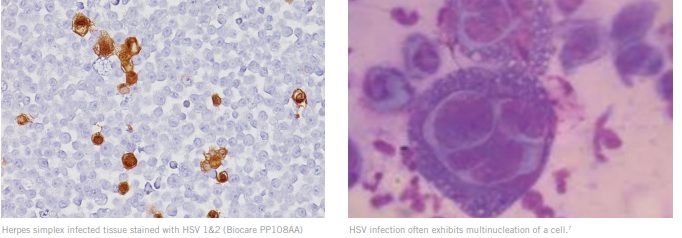A Simple Solution to Identifying Herpes Simplex 1 & 2 through Immunohistochemistry
A Simple Solution to Identifying Herpes Simplex 1 & 2
Through Immunohistochemistry Methods
Herpes simplex virus types 1 and 2 (HSV-1 and HSV-2) are common, lifelong infections, which often have no symptoms 1. People with symptoms
may have painful blisters or sores at the site of infection 2,3. The viruses are transmitted through contact with an infected person’s lesion, mucosal
surface, or genital or oral secretions. Traditionally, microbial identification in infectious diseases have been made primarily by using serologic
assays and cultures, however, serologic results can be difficult to interpret in the setting of immunosuppression or when only a single sample is
available for evaluation.4 In addition, fresh tissue is not always available for culture and culture of fastidious pathogens can be difficult and may
take weeks or months to yield results.4 While some microorganisms have distinctive morphologic characteristics that allow their identification, in
several instances it is difficult or even impossible to identify an infectious agent specifically by conventional morphologic methods.4
Immunohistochemistry is one of the most powerful techniques in surgical pathology. There has been an increasing interest in the use of specific
antibodies to viral, bacterial, fungal, and parasitic antigens in the detection and identification of the causative agents in many infectious diseases.
In many instances, immunohistochemistry has shown high specificity, allowing the differentiation of morphologically similar microorganisms.5
The diagnosis of herpes simplex virus (HSV) infection can be difficult when the characteristic intranuclear inclusions or multinucleated cells, or
both, are absent or when the amount of tissue in a biopsy specimen is small.6 In these cases, immunohistochemistry using either polyclonal or
monoclonal antibodies against HSV antigens has proven to be a sensitive and specific technique to diagnose HSV infections.6
Biocare Medical has recently re-released a polyclonal HSV I&II primary antibody cocktail that reacts with the major viral envelope glycoproteins
and with core proteins. In addition, this antibody will not cross-react with cytomegalovirus, Epstein-Barr virus or varicella zoster virus. This
product is compatible with FFPE tissue samples and can be utilized on automated IHC staining platforms or manual staining applications.
To learn more about the HSV 1 & 2, please contact Biocare anytime at 800-799-9499 or click the link here:
https://biocare.net/product/herpes-simplex-virus-1-2-antibody/
1. Tronstein E, Johnston C, Huang ML, Selke S, Magaret A, Warren T, et al. Genital shedding of herpes simplex virus among symptomatic and asymptomatic persons with HSV-2 infection. JAMA 305(14):1441–9. 2011.
2. Ryder N, Jin F, McNulty AM, Grulich AE, Donovan B. Increasing role of herpes simplex virus type 1 in first-episode anogenital herpes in heterosexual women and younger men who have sex with men, 1992–2006. Sex Transm
Infect 85(6):416–9. 2009.
3. Bernstein DI, Bellamy AR, Hook EW 3rd, Levin MJ, Wald A, Ewell MG, et al. Epidemiology, clinical presentation, and antibody response to primary infection with herpes simplex virus type 1 and type 2 in young women. Clin Infect
Dis 56(3):344–51. 2013.
4. Eduardo Eyzaguirre and Abida K. Haque (2008) Application of Immunohistochemistry to Infections. Archives of Pathology & Laboratory Medicine: March 2008, Vol. 132, No. 3, pp. 424-431.
5. Cohen, P. R. Tests for detecting herpes simplex virus and varicella-zoster virus infections. Dermatol Clin 1994. 12:51–68.
6. Greenson, J. K. , W. E. Beschorner , and J. K. Boitnott . et al. Prominent mononuclear cell infiltrate is characteristic of herpes esophagitis. Hum Pathol 1991. 22:541–549.
7. Khatri, H., Herpes Simplex Virus (HSV) and Varicella Zoster Virus ( VZV), 9 August 2018, https://www.slideshare.net/DrHimanshuKhatri/herpes-simplex-virus-hsv-and-varicella-zoster-virus-vzv-by-dr-himanshu-khatri


